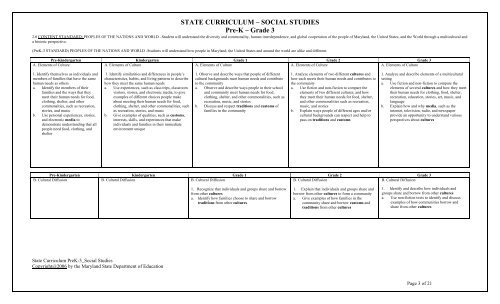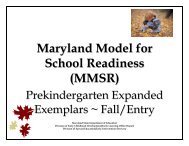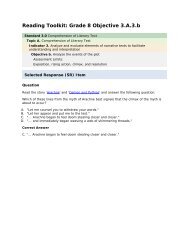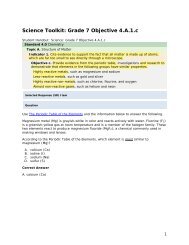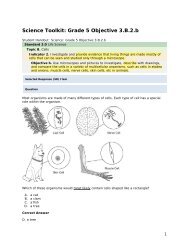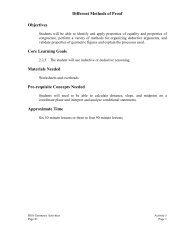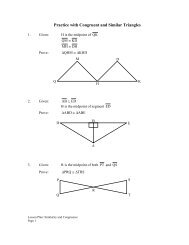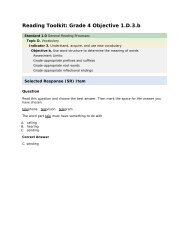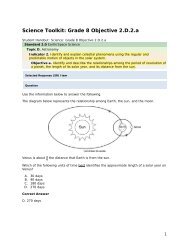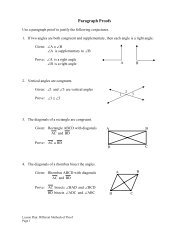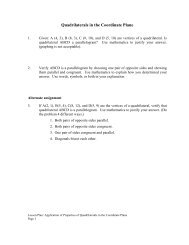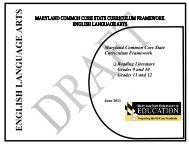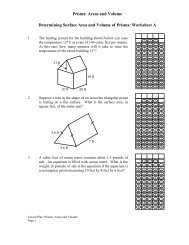Maryland State Curriculum - mdk12
Maryland State Curriculum - mdk12
Maryland State Curriculum - mdk12
- TAGS
- maryland
- curriculum
- mdk12.org
You also want an ePaper? Increase the reach of your titles
YUMPU automatically turns print PDFs into web optimized ePapers that Google loves.
<strong>State</strong> <strong>Curriculum</strong> PreK-3_Social Studies<br />
Copyright@2006 by the <strong>Maryland</strong> <strong>State</strong> Department of Education<br />
STATE CURRICULUM – SOCIAL STUDIES<br />
Pre-K – Grade 3<br />
2.0 CONTENT STANDARD: PEOPLES OF THE NATIONS AND WORLD –Student will understand the diversity and commonality, human interdependence, and global cooperation of the people of <strong>Maryland</strong>, the United <strong>State</strong>s, and the World through a multicultural and<br />
a historic perspective.<br />
(PreK-3 STANDARD) PEOPLES OF THE NATIONS AND WORLD -Students will understand how people in <strong>Maryland</strong>, the United <strong>State</strong>s and around the world are alike and different.<br />
Pre-Kindergarten Kindergarten Grade 1 Grade 2 Grade 3<br />
A. Elements of Culture<br />
A. Elements of Culture<br />
A. Elements of Culture<br />
A. Elements of Culture<br />
A. Elements of Culture<br />
1. Identify themselves as individuals and<br />
members of families that have the same<br />
human needs as others<br />
a. Identify the members of their<br />
families and the ways that they<br />
meet their human needs for food,<br />
clothing, shelter, and other<br />
commonalties, such as recreation,<br />
stories, and music<br />
b. Use personal experiences, stories,<br />
and electronic media to<br />
demonstrate understanding that all<br />
people need food, clothing, and<br />
shelter<br />
1. Identify similarities and differences in people’s<br />
characteristics, habits, and living patterns to describe<br />
how they meet the same human needs<br />
a. Use experiences, such as class trips, classroom<br />
visitors, stories, and electronic media, to give<br />
examples of different choices people make<br />
about meeting their human needs for food,<br />
clothing, shelter, and other commonalities, such<br />
as recreation, stories, and music<br />
b. Give examples of qualities, such as customs,<br />
interests, skills, and experiences that make<br />
individuals and families in their immediate<br />
environment unique<br />
1. Observe and describe ways that people of different<br />
cultural backgrounds meet human needs and contribute<br />
to the community<br />
a. Observe and describe ways people in their school<br />
and community meet human needs for food,<br />
clothing, shelter, and other commonalities, such as<br />
recreation, music, and stories<br />
b. Discuss and respect traditions and customs of<br />
families in the community<br />
1. Analyze elements of two different cultures and<br />
how each meets their human needs and contributes to<br />
the community<br />
a. Use fiction and non-fiction to compare the<br />
elements of two different cultures, and how<br />
they meet their human needs for food, shelter,<br />
and other commonalities such as recreation,<br />
music, and stories<br />
b. Explain ways people of different ages and/or<br />
cultural backgrounds can respect and help to<br />
pass on traditions and customs<br />
1. Analyze and describe elements of a multicultural<br />
setting<br />
a. Use fiction and non-fiction to compare the<br />
elements of several cultures and how they meet<br />
their human needs for clothing, food, shelter,<br />
recreation, education, stories, art, music, and<br />
language<br />
b. Explain how and why media, such as the<br />
internet, television, radio, and newspaper<br />
provide an opportunity to understand various<br />
perspectives about cultures<br />
Pre-Kindergarten Kindergarten Grade 1 Grade 2 Grade 3<br />
B. Cultural Diffusion<br />
B. Cultural Diffusion<br />
B. Cultural Diffusion<br />
B. Cultural Diffusion<br />
B. Cultural Diffusion<br />
1. Recognize that individuals and groups share and borrow<br />
from other cultures<br />
a. Identify how families choose to share and borrow<br />
traditions from other cultures<br />
1. Explain that individuals and groups share and<br />
borrow from other cultures to form a community<br />
a. Give examples of how families in the<br />
community share and borrow customs and<br />
traditions from other cultures<br />
1. Identify and describe how individuals and<br />
groups share and borrow from other cultures<br />
a. Use non-fiction texts to identify and discuss<br />
examples of how communities borrow and<br />
share from other cultures<br />
Page 3 of 21


